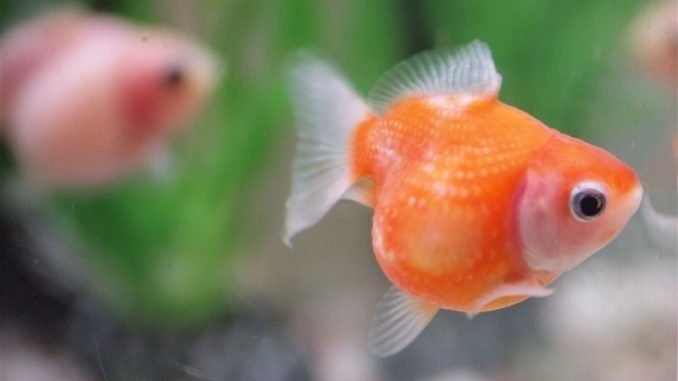
The pearlscale goldfish (chinshurin in Japanese) is a selectively bred fancy goldfish. Pearlscale goldfish are part of the Cyprinidae family and are a relatively new species, with their origin being traced back to the early 1900s in China.
As the name pearlscale goldfish suggest, this variety of goldfish has pearl-like scales. These fish also have egg-shaped bodies, making them highly popular among aquarists.
Pearlscales are hardy fish with a peaceful temperament. They are easy to look after but can catch diseases such as swim bladder disease easily.
TABLE OF CONTENTS
Pearlscale Goldfish Facts & Overview
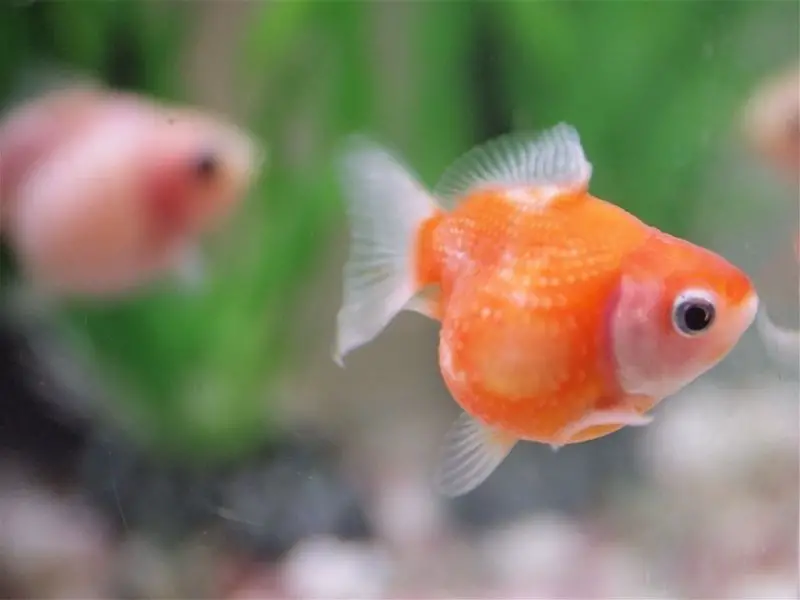
| Category | Rating |
| Care Level: | Easy |
| Temperament: | Peaceful |
| Color: | White, calico, orange or black |
| Lifespan: | ~10 years |
| Size: | ~6 inches |
| Diet: | Omnivores |
| Family: | Cyprinidae |
| Minimum Tank Size: | 20-gallons |
| Tank Setup: | Freshwater, plants, cool water, fine-grained substrate |
| Compatibility: | Other docile freshwater species |
The pearlscale goldfish (Carassius auratus) belongs to the Cyprinidae family. This fish is a new variety of fancy goldfish.
The Cyprinidae family is made up of freshwater fish. Carp, minnows, koi, and other goldfish are all part of the Cyprinidae family.
Pearlscales have an average lifespan of 10 to 15 years. A large tank size, well-maintained water, and a nutritious diet will help to increase their lifespan.
The pearlscale goldfish was developed in China at the start of the 20th century. These fish were later imported to Japan in the 1950s. The pearlscale was modified over time to give it the qualities we’re familiar with today.
Pearlscale goldfish are easy to find worldwide. Most pet stores stock pearlscales thanks to their popularity and hardiness. Aquarists can expect to pay between $12 and $25 per fish. Large pearlscale goldfish will cost more.
The pearlscale goldfish has domed scales with a pearl-like appearance. This fish is also called the golfball goldfish or ping-pong goldfish.
Pearlscale goldfish are captive-bred and are not found naturally in the wild. They are hardy and can tolerate various water conditions. The ideal water temperatures for pearlscale goldfish are between 65°F and 72°F.
Appearance & Behavior
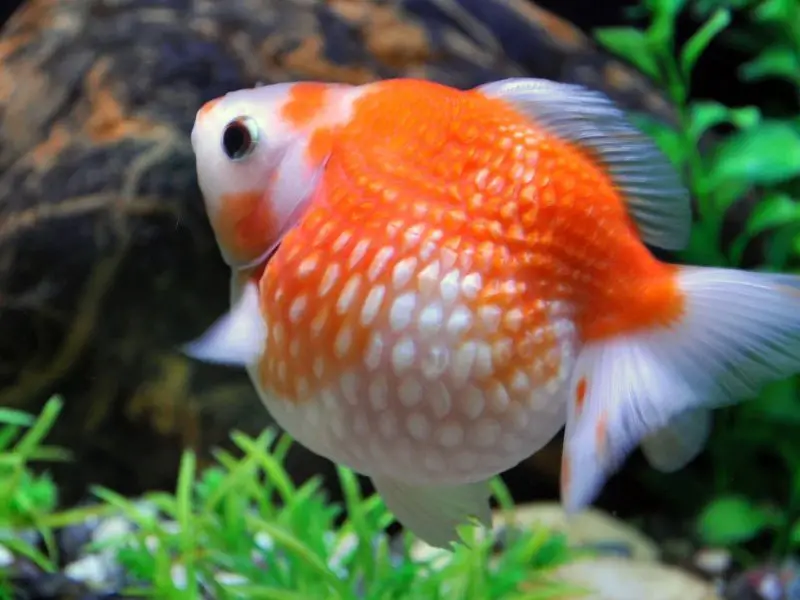
The pearlscale goldfish is a medium-sized freshwater species. Adult fish measure between four and ten inches long.
The pearlscale goldfish has a plump head and around the body. Its scales are thick and look like pearls arranged in rows. Each scale has a raised white center caused by calcium carbonate deposits.
The pearlscale goldfish comes in a wide range of hues. The most popular fish colors are white, orange, calico, and black.
Pearlscale goldfish have a single dorsal (top) fin. Their caudal (tail) fin is well-developed and split. A pearlscale’s finnage is translucent with rounded tips. The fish’s fins flow elegantly in the water.
Some pearlscales have a prominent, bubble-like head growth, called a wen. Pearlscales with a wen are called high-head pearlscales or crown pearlscales.
Distinguishing between male and female fish is impossible until they reach full sexual maturity. Pearlscale goldfish take a year to mature. Inspect an adult fish’s pectoral fins to identify the sex of the pearlscale. Male pearlscale goldfish have a longer first ray than female fish. Males are also smaller and thinner than female fish.
Pearlscale goldfish show physical signs of sexual maturity when they are ready to breed. Males develop light bumps called tubercles on the first ray of their pectoral fins and gill plates, while female fish become round and plump.
Pearlscale goldfish lose their bright hues when subjected to stress. Fish become stressed due to sudden changes in water conditions, inappropriate tank size, and high ammonia or nitrate levels in the tank.
Typical Behavior
Pearlscale goldfish are peaceful and social. These mid-dwelling fish make wonderful additions to community tanks.
Pearlscale goldfish are weak swimmers due to their egg-like body shape. They are slow-moving but active fish that have a “wobbly” swimming style. Pearlscales enjoy foraging and often explore the lower levels of the tank.
They are not territorial, but males often show aggression toward one another while breeding. Keeping the tank setup appropriate will reduce conflict. Stress can also cause fighting or bullying behavior.
Pearlscale goldfish are the most active during the day. Feed pearlscales in the daytime and keep their tank dark in the evening.
Fish sleep with their eyes open. The following behavior indicates the fish is resting:
- Hovering near the bottom of the tank
- Staying stable and upright
- Looking dull
- Less alert
- Startles easily
- Looking inactive
Goldfish are intelligent and don’t have a 3-second memory, despite common misconceptions. A 2003 research study found that goldfish have a long-lasting memory. The study discovered that goldfish can also differentiate shapes, sounds, and colors. They can even be trained to exhibit certain behaviors and perform tricks.
Pearlscale goldfish can recognize people. These goldfish will surface for food when their fishkeeper approaches.
Pearlscale Goldfish Care
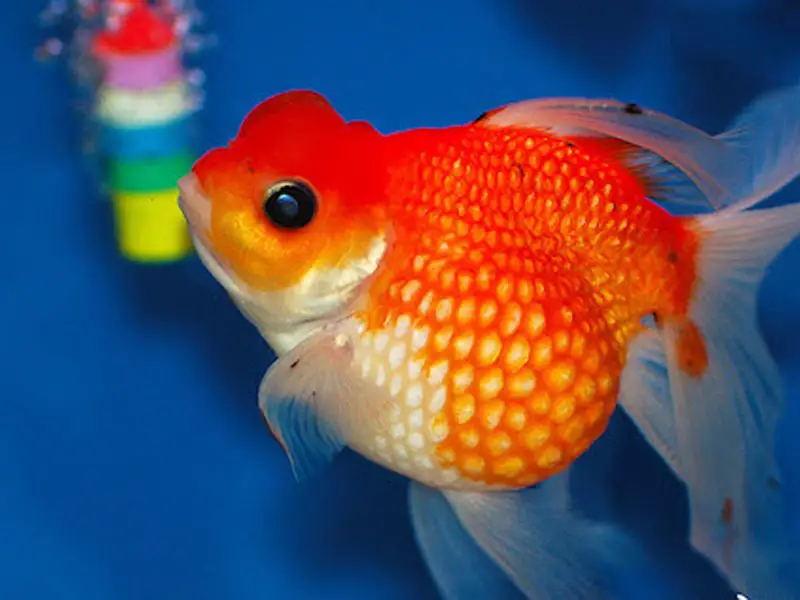
Pearlscale goldfish are easy to care for. They are peaceful, social, and hardy fish. These are beginner-friendly fish as long as their needs are met.
Pearlscales do best in slow-moving, cold water with moderate hardness. Because they produce a lot of waste, water needs to be changed regularly. Water changes will reduce stress and prevent disease outbreaks.
Pearlscales are omnivores with an insatiable appetite for live food like brine shrimp to vegetables like peas. Avoid overfeeding them.
These fish are delicate. Remove sharp or jagged accessories from a pearlscale goldfish tank.
Habitat and Tank Requirements
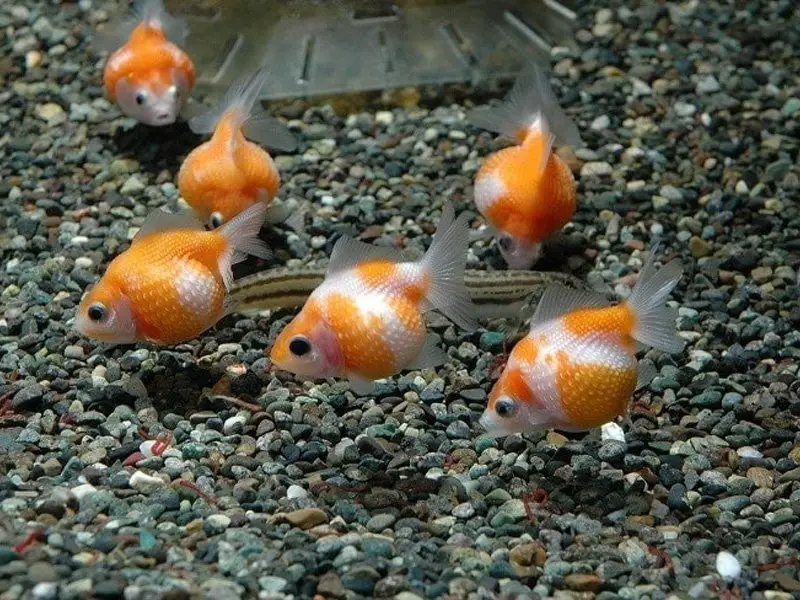
Pearlscale goldfish are captive-bred descendants of the carp. Carps thrive in highly vegetated rivers, ponds, and lakes with slow-moving currents. They prefer soft sediment and a water pH level between 6.5 and 8.0.
Tank Conditions
While pearlscales are hardy and can handle most water conditions, they thrive in moderately hard water (5 to 19 dKH) with a neutral pH (6.5 to 7.5). Keep the water cool. Water temperature between 65°F to 72°F is ideal.
Pearlscale goldfish can live in pond setups. Take extra measures to keep the environment safe and water parameter changes to a minimum.
Pearlscale goldfish produce a lot of waste. Weekly water changes of 25% and reliable filtration are a must. Filtration systems clear waste and debris from the water. Pearlscale goldfish are poor swimmers so avoid filters that generate strong currents.
Pearlscale goldfish require a lot of oxygen, so opt for an elongated tank rather than a tall one. The larger the surface area, the more oxygen the tank will have.
Plants can further help to keep the water oxygenated. The plants in a pearlscale goldfish tank must be hardy. Pearlscales enjoy scavenging and will eat and uproot live plants.
The following plants are suitable in a pearlscale goldfish tank:
Tying plants to the decor or adding a weighted base will stop the pearlscales from uprooting the plants.
Two pearlscale goldfish will thrive in a 20-gallon tank. Each additional pearlscale goldfish requires another 10 gallons of water. Consider increasing the tank size by 20 gallons for fish that are over 10 inches. An overcrowded fish tank will cause conflict between the fish. Community tanks containing pearlscale goldfish should hold at least 40 gallons of water or more.
A pearlscale goldfish’s domed scales are delicate. Damaged scales grow back flat and lose their pearl-like look. To reduce the chance of scale damage, avoid keeping décor with rough textures or sharp edges. You should also opt for a fine-grained, soft substrate.
Minimize water evaporation by putting a lid on the fish tank. Keeping a lid on the fish tank will prevent the fish from jumping out of the tank.
Tank Mates
Pearlscales are compatible with most docile species that share similar habitat preferences. Dojo loaches, banded corydoras, and other fancy goldfish varieties like fantails and black moors are ideal tank mates. Large freshwater invertebrates, such as mystery snails, are compatible with pearlscale goldfish as well.
Avoid putting pearlscales with fast swimming or boisterous fish. Pearlscale goldfish are slow swimmers and struggle to swim away from aggressive fish or compete for food. Betta fish, barbs, cichlids, and tiger barbs are not suitable in a pearlscale goldfish tank.
Tank mates should always be similar in size. Pearlscale goldfish will eat anything that fits in their mouth, including small fish.
Diseases
Pearlscale goldfish are prone to swim bladder disease due to their egg-shaped body. It compresses the fish’s organs and puts pressure on their swim bladder.
Swim bladder disease hinders buoyancy and is caused by rapid eating, overeating, or constipation. An infection can also cause swim bladder disease and requires medical treatment.
Swim bladder symptoms include:
- A swollen belly
- Sinking to the bottom or floating near the top of the tank
- Tilting side to side
- Floating head down tail up
Fish suffering from swim bladder disease are easy to treat. Do not feed a fish for three days to treat swim bladder disease. Raising the temperature in the tank will treat constipation.
After three days feed your pearlscale a cooked pea daily with the outer shell removed. Peas can help with digestive problems as they are dense and high in fiber. Feed the peas by hand to fish that are struggling to eat. Either hold the pea at the water’s surface or put a pea on a toothpick and hold it near them.
Swim bladder disease is not always treatable. Consider euthanasia if symptoms continue.
Below are some measures that help prevent swim bladder disease:
- Soak dried foods before feeding them to your fish
- Completely thaw frozen foods
- Don’t overfeed
- Avoid air-filled foods
- Switch to sinking foods if your pearlscale gulps a lot of air when eating surface level food
- Keep water well-maintained and change regularly
Diet and Feeding
Pearlscale goldfish are omnivores. Pellets, frozen food, vegetables, and live food make up a pearlscale goldfish diet.
Flakes or pellets that have a high carbohydrate content and low protein content are ideal for pearlscale goldfish. Occasionally incorporate leafy vegetables and cooked peas with the shells removed. Vegetables aid digestion and can help prevent constipation.
Pearlscale goldfish are renowned for their voracious appetite. They will eat continuously if given the opportunity. They are prone to overeating, so keep portion sizes at an appropriate amount. Pearlscales should be able to consume all the food within two to three minutes.
Feed pearlscales twice daily. Soak flakes and pellets and thaw frozen food before feeding the fish. This will minimize the risk of stomach swelling.
Avoid feeding your pearlscale air-filled foods that expand in water. These foods can cause constipation and swim bladder disease.
Breeding
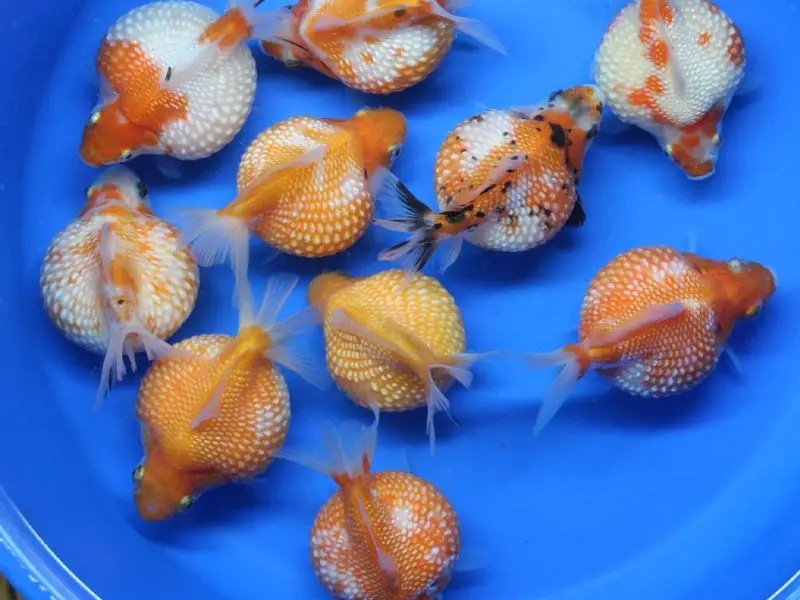
Separate the male and female pearlscales. Incorporate more protein into their diet to encourage breeding. Live foods like bloodworms and brine shrimp are a great source of protein.
Set up a breeding tank for each pair. A 20-gallon tank with slow-moving water is ideal for breeding fish. The tank should also contain something for the eggs to adhere to. Soft plants such as Anacharis or a dedicated spawning mop are great additions to a breeding tank.
Breeding tanks should contain a sponge filter. Sponge filters are safer for fry than normal filters.
Increase the temperature by 3°F per day until the temperature reaches 74°F to help encourage spawning. Once the pearlscales are ready to breed, the male will chase the female around. Their coloration may also become more vibrant.
Female pearlscales lay around a thousand eggs. Spawning typically takes three hours, though sometimes it can last longer. Remove the pair immediately once the eggs have been released, otherwise, the pair will eat the eggs.
The fertilized eggs will hatch within four days. Feed the fry infusoria. Feed juvenile fish flakes and brine shrimp.
Monitor the water parameters closely. Fry are exceptionally sensitive to water changes, especially changes in pH.
Pearlscales goldfish take several months to develop. Immature fish are a dull color and have flat bodies.
Should You Get a Pearlscale Goldfish for Your Aquarium?
Pearlscale goldfish are a great choice for beginners and experienced fishkeepers. They are affordable, docile, and easy to care for. They make great additions to cold water community tanks.
Pearlscales are not ideal for tanks that home fast-moving or aggressive fish. They are weak swimmers, and won’t be able to protect themselves or compete for food.
However, in the right tank conditions, these fish will flourish and transform any aquarium into a captivating attraction with their beautiful scales, flowing fins, and wonderful personalities.

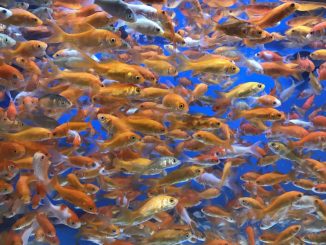
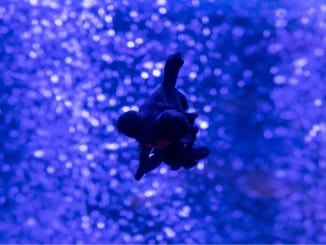
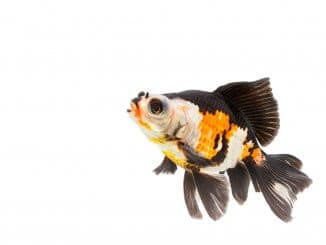

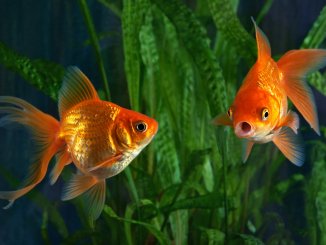
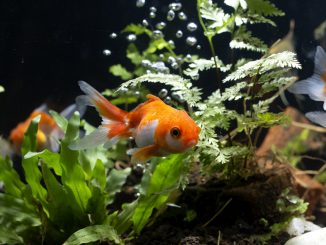

Can I keep my 36 gallon tank at 80 degrees with 2 pearl scales in it?